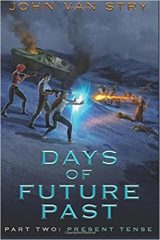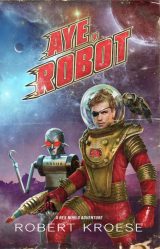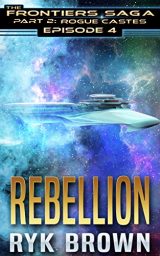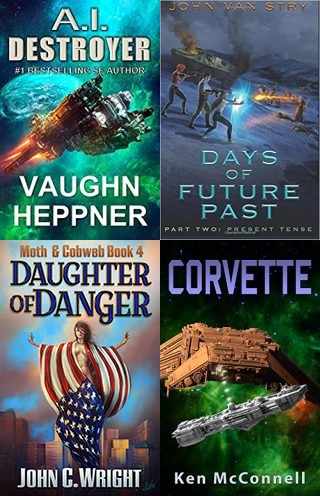
Every other month, the Castalia House blog showcases books published by independent authors and small presses. This month, we take a look back at the new releases published in February and March to offer a sample of the science fiction and fantasies waiting for those readers who are willing to look beyond the brick and mortar bookstore. These adventures include:
- A freshly awakened mercenary cadet must shake off the effects of cryosleep to save his ship, his regiment, and his solar system from killer robots.
- A time-traveler is on a mission from the Navajo gods to take a suitcase nuke into a dragons’ nest.
- A space trucker’s attempt at salvage nets him a space princess – and the wrath of her metal men pursuers.
- A newly resurrected captain must lead an interstellar insurgency and find a new home for the survivors of a destroyed planet.
- An aging and expendable corvette is armed to the teeth and sent to investigate a missing explorer’s distress beacon.
- An amnesiac Japanese woman wakes up in an American hospital with nothing more to her name than a magic ring and a mission from a heavenly saint.
Let’s take a closer look.
* * * * *
A. I. Destroyer (A. I. series) – Vaughn Heppner
Mercenary cadet Jon Hawkins is crash-decanted from cyrosleep. As he struggles to overcome the memory problems caused by the emergency process, he must figure out how to save his ship from the robots slaughtering the crew and the political officer killing his sleeping regiment. After that, he must somehow rally the remnants of his mercenary company to fly the crippled ship – and fight against the alien behemoth that just razed the floating cities of Neptune before it can invade the rest of the solar system.
Heppner excels at rehabilitating the old tropes, polishing them up, and giving them a fresh coat of paint. A. I. Destroyer features the classic amnesiac hero, killer computers, and an alien invasion by synthetic life, but places enough of a spin on each to avoid cliche. But what shines the most amid this taut thriller are the extended boarding action that makes up the final half of the book and the study of the character of command. But where many mil-sf writers concern themselves with the expressions of character in relationships with subordinates and superiors, excusing personal foibles with the insistence that “single men in barricks don’t grow into plaster saints,” Heppner instead focuses on the inward qualities needed by a leader.
* * * * *
Days of Future Past – Part 2: Present Tense – John van Stry
When the Navajo gods plucked a hero from the present to save the future, they picked up a spare. Now, while Riggs unites the Navajo tribes against the dragons and sorcerers that ravage the Earth five hundred years from now, Paul Young serves as the trickster god Coyote’s errand boy. Accompanied by his two lovers, Paul accomplishes the secret missions that ensure the success of the hero of legend, keeping away from the man who despises him. This time, Coyote tells Paul to transport a suitcase nuke into a dragon’s nest. But before Paul can reach the nest, he must first deal with the California wastelands, sorcerers, elves, dwarves, and his two wives.
Present Tense is reminiscent of Shadowrun, but with the cyberpunk urban jungles replaced by rural post-apocalyptic fantasy. The Navajo dressings and the main character working for the hero of legend as opposed to being said hero help distinguish Present Tense from other fantasies post-apocalyptic and otherwise, although the effect is diminished by the fantasy constants of elves and dwarves. The polygamist romance elements induce eye-rolls, but are tame compared to what might be found in works by Heinlein, John Ringo, or the average paranormal romance. All in all, Present Tense makes for a good beach read, and a far sight better than many of thrillers that try to fill the men’s adventure niche.
* * * * *
Aye, Robot (Starship Grifters #2) – Robert Kroese
Aye, Robot includes the novella, “The Yanthus Prime Job,” reviewed here.
After unknowingly arranging a hostile takeover of a competing cult for the Space Apostles, infamous grifter Rex Nihilo and his robot Friday Sasha find themselves mindwiped and aimed at a new target for fleecing. An incomplete memory job allows Sasha to remember what led to this disaster: Rex trying his hand at space piracy and spontaneous salvage of a Space Apostles’ satellite. But with debts to Pepper Melange mounting, it’s time for payback: credits to Pepper, and revenge to the Space Apostles.
Not many authors try to follow in the steps of Douglas Adams and Terry Pratchett. Even fewer succeed in crafting satire that is both funny and a moving story. Either the jokes collapse under the dramatic impulse, or the story becomes nothing more than a vehicle to carry to reader to the next gag. Aye, Robot hits the mark more often than not with its humor, often with a wink, a nod, and a dreadful pun towards the audience. At the same time, the chain of heists that Rex sets out on would stand on their own in a more serious mystery. Rex’s journey from pirated to pirate to kidnapper and kidnapped is not driven by absurd humor, but rather the desire of a man who wants to spend it all and right now. Sasha does her best to rein in Rex’s impulsiveness, but usually only manages to steer him into a slightly less rash course of action. And swept up in the course of Rex’s whirlwind is Pepper Melange, possibly the only sane woman in the galaxy. Space might be big, really big, but Rex Nihilo will always find trouble and an unsuspecting mark.
* * * * *
Rebellion (Frontiers Saga: Rogue Castes #4) – Ryk Brown
With his memory downloaded into his clone, Captain Nathan Scott must integrate two sets of memories and personalities into one. But the time needed to do so is a luxury. The Dusahn caste is consolidating their conquest of the Pentaurus cluster, glassing planets that resist. As Captain Scott’s Ghatazhak regiment leaves behind one shattered world after another, they must find a new refuge without risking more innocent lives. But their allies on Earth are unwilling to extend their fleet beyond their defensive positions. So Captain Scott returns to the asteroid fields to reignite the Karuzari rebellion that once liberated the Pentaurus, this time against the Dusahn. Their first act is to capture a jump-capable luxury cruiser large enough to house the refugees that fled with the Ghatazhak regiment. But pirates and the Dusahn military also have their eye on the luxury cruiser, leaving Captain Scott no choice but to race for the ship.
If Resurrection returned the Rogue Castes series to the classic form of the Frontiers Saga, Rebellion continues in the course it charted, adding a sprinkling of cloak and dagger to the already successful space opera action. The Karuzari have to recruit, after all, and sneaking operatives past the Dusahn patrols requires ingenuity. The highlight is the taking of the luxury liner, a mission that goes horribly wrong as both pirate rivals of Scott’s clone and the Dusahn arrive to lay claim to the vessel. At his best, Nathan Scott is not a tactical or technical genius, but an inspirational leader. As he sneaks around the luxury liner with the assault team, Scott is not at his best. But his clone’s memories do come in handy in the engine room. Although Rebellion takes advantage of the dual memories, it avoids many of the common pitfalls of cloning stories rampant in indie science fiction. Instead, it is used to enable what Brown does best, adrenaline-fueled space opera action.
* * * * *
Corvette – Ken McConnell
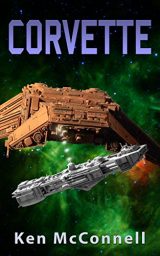 A distress beacon by an Exploration ship prompts the Federation to send a corvette, the Weippe, to investigate, but not before the ship is overhauled with additional armor, weapons, and marines far beyond that demanded by normal peacetime operations. the Weippe, as the oldest ship in the fleet, is expendable, and Lieutenant Amon Vance thinks the same about his career. But when the Wieppe recovers the dead crew of the Exploration ship, they find a live alien and an angry alien warship. Now the crew of the Wieppe must outwit and outfight these new foes to ensure the Federation knows about this first contact.
A distress beacon by an Exploration ship prompts the Federation to send a corvette, the Weippe, to investigate, but not before the ship is overhauled with additional armor, weapons, and marines far beyond that demanded by normal peacetime operations. the Weippe, as the oldest ship in the fleet, is expendable, and Lieutenant Amon Vance thinks the same about his career. But when the Wieppe recovers the dead crew of the Exploration ship, they find a live alien and an angry alien warship. Now the crew of the Wieppe must outwit and outfight these new foes to ensure the Federation knows about this first contact.
Corvette is a prequel to McConnell’s Star Saga series. The aliens might be a little too human, but Corvette delivers a military sci-fi story without the typical quirky crew, insubordination, or action girls and guys. Just a quiet, competent crew handling their duties and combat actions with professionalism and discipline. This does undermine the drama a bit. However, in a genre that gravitates towards rogues, rejects, and other military special snowflakes, tales of competent professionals are a welcomed change of pace.
* * * * *
Sudden Rescue – Jon Mollison
Disclosure: Jon Mollison is a fellow Castalia House blogger. The reviewer also blogs with him at the Puppy of the Month Book Club.
 After encounters with space priates and Syntharcy metal men crater the profitability of space trucker E. Z. Sudden’s latest delivery, the well-worn captain salvages four safe boxes from the wreckage of a recent Synth attack to offset his costs. The contents only bring more trouble, as inside is Karenina, a princess of the Majesterium, who is late to her own wedding – and the key to stopping an impeding war between the Syntharcy and the Majesterium. Pursued by Synths and pirates, Sudden must get Karenina back to her family, even if it means flying through a Syntharcy harvester fleet to do so.
After encounters with space priates and Syntharcy metal men crater the profitability of space trucker E. Z. Sudden’s latest delivery, the well-worn captain salvages four safe boxes from the wreckage of a recent Synth attack to offset his costs. The contents only bring more trouble, as inside is Karenina, a princess of the Majesterium, who is late to her own wedding – and the key to stopping an impeding war between the Syntharcy and the Majesterium. Pursued by Synths and pirates, Sudden must get Karenina back to her family, even if it means flying through a Syntharcy harvester fleet to do so.
Science fiction tends to forget the middle-aged men that fall between the young bucks and the grandfather mentors so beloved of the genre. Also lost in the constant march of chosen ones, rogues, aristocratic rakes, and military men is the regular joe grinding out his living one shift at a time. Space trucker E. Z. Sudden fills this unique niche, a more experience (and less gullible) Northwest Smith more concerned with making his delivery schedule than chasing adventure and renown. But when adventure find him, Sudden rises to the challenge, returning Karenina to her family because it is the right thing to do and not for reward. Sudden Rescue is a fun adventure in the pattern of the classic pulps, complete with the plot twists and glimpses into wider mysteries. Hopefully there will be more stories in this setting.
* * * * *
Bakemonogatari Part 02 – NISIO ISIN
 Since turning into a vampire during his spring break, Koyomi Araragi has been forced to deal with supernatural aberrations. While he might have regained his humanity, his life has yet to return to normal. Freeing Hitagi Senjougahara from her curse might have netted Koyomi a girlfriend, but the aberrations keep coming in the second volume of Bakemonogatari. In “Suguru Monkey,” he must deal with one of Hitagi’s admirers stalking him. But to get the sapphically inclined Suguru Kanbaru to leave him alone, he must free her from the cursed monkey’s paw in her arm. While in “Nadeko Snake,” Koyomi must team up with Suguru to free a childhood friend from a snake curse. It’s a race, for if the snake scale markings creeping up Nadeko Sengoku’s body reach her neck, she will die. Meanwhile, Tsubasa Hanekawa prowls through these tales like the Ghost Cat that Koyomi fought during spring break…
Since turning into a vampire during his spring break, Koyomi Araragi has been forced to deal with supernatural aberrations. While he might have regained his humanity, his life has yet to return to normal. Freeing Hitagi Senjougahara from her curse might have netted Koyomi a girlfriend, but the aberrations keep coming in the second volume of Bakemonogatari. In “Suguru Monkey,” he must deal with one of Hitagi’s admirers stalking him. But to get the sapphically inclined Suguru Kanbaru to leave him alone, he must free her from the cursed monkey’s paw in her arm. While in “Nadeko Snake,” Koyomi must team up with Suguru to free a childhood friend from a snake curse. It’s a race, for if the snake scale markings creeping up Nadeko Sengoku’s body reach her neck, she will die. Meanwhile, Tsubasa Hanekawa prowls through these tales like the Ghost Cat that Koyomi fought during spring break…
The banter that dragged down the second half of the first volume takes a back seat to the more pressing concerns of preventing supernatural aberrations from killing Koyomi and Nadeko. Yet obscured by these adventures is an examination of social roles and social pressures. Each of the main characters in Bakemonogatari cope with their problems by retreating into ideals: the perfect student, the perfect athlete, the perfect shrew, the perfect loser and the perfect housewife. In Suguru’s case, she’s also the perfect model of the trendy unfeminine. When facing their aberrations, the characters also are forced to confront their problems in the natural. Afterwards, they are free to cast aside the social role they used to hide their pain. At its best, Bakemonogatari combines adventure and character development into briskly moving tales of supernatural hauntings. However, it was also written at a time where segments of the Japanese entertainment industry began courting the money of a small but rabid fan base. For some, Bakemonogatari will instead be a tour of the tropes and conventions that drove many fans away from anime and manga.
* * * * *
Daughter of Danger (Moth & Cobweb #4) – John C. Wright
Disclosure: John C. Wright is a fellow Castalia House blogger. The reviewer is a contributor to Wright’s Patreon for the pulp serial Superluminary.
 A young Japanese woman wakes up in a hospital, with no memory but for a mission from the saint that returned her to the living. With a magic ring and a flimsy hospital gown her only possessions, “Ami” escapes from goatmen and werewolves sent to kill her and steal back the ring. Now lost on the streets of New York City, Ami seeks to recover her memories with the help of Elfine, a fairy-like Moth girl with more than a passing resemblance to Tinkerbell. But the werewolves are never far off Ami’s trail, and Elfine soon goes missing. Ami must confront the werewolves to rescue her friend, a daunting task for anyone. Fortunately, among Ami’s recovered memories is her training as a kunoichi, a female ninja.
A young Japanese woman wakes up in a hospital, with no memory but for a mission from the saint that returned her to the living. With a magic ring and a flimsy hospital gown her only possessions, “Ami” escapes from goatmen and werewolves sent to kill her and steal back the ring. Now lost on the streets of New York City, Ami seeks to recover her memories with the help of Elfine, a fairy-like Moth girl with more than a passing resemblance to Tinkerbell. But the werewolves are never far off Ami’s trail, and Elfine soon goes missing. Ami must confront the werewolves to rescue her friend, a daunting task for anyone. Fortunately, among Ami’s recovered memories is her training as a kunoichi, a female ninja.
The fourth book of Moth & Cobweb opens with a new heroine and a new tone. Where Wright’s young heroes tend to carry themselves with an surfeit of boldness and exuberance, his heroines are grounded in a more cautious pragmatism. “Ami” is older and more mature than Gil Moth, with a grittier story aimed at the older end of the young adult audience. New York City is more befitting of the Shadow or Batman than the bright tales of the Swan Knight, and Ami’s adventure follows suit. While Ami allows Wright to add a Japanese lacquer to the world of Moth & Cobweb, it remains grounded in its foundation of Welsh and Christian folklore including the elves and the Thirteen Treasures of Britain. Ties to the previous three books reward the Moth & Cobweb veterans, but new readers to the series will find Daughter of Danger a welcoming introduction to the Twilight people and the Moth clan.
I have Aye, Robot sitting on my phone, so I might bump it up the reading list.
Useful post. Thanks.
Daughter of Danger is excellent. I also liked first book of Days of Future Past series. Thanks for interesting sci-fi tips.

